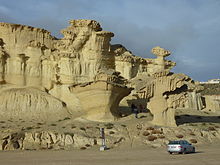- Ciudad Encantada Bolnuevo
-
Las Gredas de Bolnuevo, also called Ciudad Encantada (enchanted city) are heavily eroded sandstone formations along the beach of Bolnuevo, Murcia, Spain.[1][2]
The sandstone shapes are sculpted by water and wind over thousands of years and are considered as a monument of natural interest. The Ciudad Encantada is formed by clay (gredas). The yellowish color is caused by the large amount of sand contained in the clay. Furthermore the clay consists of microfossils that date from the Pliocene period, about 4.5 million years ago.
The sandstone has undergone an erosion process by the elements which resulted in mushroom and almost vertical shapes that seem to defy the laws of the gravity.
References
External links
 Media related to Ciudad Encantada Bolnuevo at Wikimedia Commons
Media related to Ciudad Encantada Bolnuevo at Wikimedia CommonsMunicipalities in the Region of Murcia Abanilla · Abarán · Águilas · Albudeite · Alcantarilla · Los Alcázares · Aledo · Alguazas · Alhama de Murcia · Archena · Beniel · Blanca · Bullas · Calasparra · Campos del Río · Caravaca de la Cruz · Cartagena · Cehegín · Ceutí · Cieza · Fortuna · Fuente Álamo de Murcia · Jumilla · Librilla · Lorca · Lorquí · Mazarrón · Molina de Segura · Moratalla · Mula · Murcia · Ojós · Pliego · Puerto Lumbreras · Ricote · San Javier · San Pedro del Pinatar · Santomera · Torre-Pacheco · Las Torres de Cotillas · Totana · Ulea · La Unión · Villanueva del Río Segura · Yecla Categories:
Categories:- Spain geography stubs
- Municipalities in Murcia
Wikimedia Foundation. 2010.

